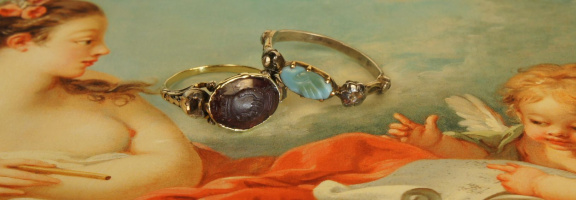
This princely Fede ring does not show the typical handshake. From around 1820 onwards, hands in German-speaking countries that are not interlaced, but hold a medallion, heart or gemstone, are becoming increasingly common. They were given as gifts of love and friendship.
Here the two right hands hold an oval faceted cut amethyst. The oval is superscript, as was customary for ring plates in the first two decades of the 19th century. According to legend, the amethyst was worn by Saint Valentine, the patron saint of lovers, and is said to symbolize deep love and loyalty, among other things. It is set in a bezel setting that is open at the bottom to let in more light and let the gem's delicate violet shine.
The setting itself is decorated with four volute-like S-shaped gold wires. Apparently, the ring bezel is held by the two right hands using an encircling, corded gold wire - a beautiful design idea!
Both wrists wear lace cuffs, which only reveal themselves as bouquets of leaves under a 10x magnifying glass. They probably represent oak leaves, as this is the symbol of immortality, steadfastness and loyalty. The cuffs are summarized by bracelets adorned with engraved dots. The ends of the sleeves are formed by two blossoms, which probably represent forget-me-nots.
The present noble Fede ring beautifully illustrates the ornamental joy and the richly decorated ring shoulders of the later Biedermeier period. The elaborate hand motif is visually enhanced with the precious stone, giving the oath of allegiance even more weight!

